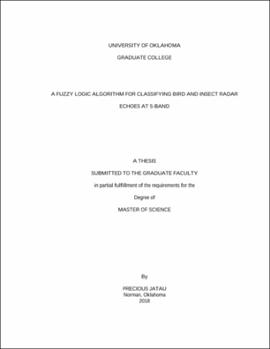| dc.contributor.advisor | Yu, Tian-You | |
| dc.contributor.author | Jatau, Precious | |
| dc.date.accessioned | 2018-08-02T18:28:38Z | |
| dc.date.available | 2018-08-02T18:28:38Z | |
| dc.date.issued | 2018-08-02 | |
| dc.identifier.uri | https://hdl.handle.net/11244/301344 | |
| dc.description.abstract | A fuzzy logic algorithm for the separation of bird echoes from insect echoes using Next Generation Radar (NEXRAD) and considering range effects has been developed. The radar used in this study is the S-band (10 cm wavelength) KTLX WSR-88D radar located in Oklahoma City. Insects are known to dominate day time clear air echoes while birds dominate nocturnal echoes during migration season. September has also been found to be peak migrating season for birds. Data was analyzed from all clear air days in September 2017 to verify the composition of clear air echoes. Results confirm insect (bird) dominance during day (night). Also, the membership functions are derived directly from the distributions of radar variables and weighted in an objective manner. Finally, the algorithm is tested on three cases. Two cases with known Monarch butterfly abundance, confirmed by the US Department of Agriculture (USDA) are correctly identified as being insect dominated. One final classification for a 24-hour period further confirms that birds (insects) are responsible for most night (day) time radar echoes. | en_US |
| dc.language | en_US | en_US |
| dc.subject | Computer Science. | en_US |
| dc.subject | Engineering, Electronics and Electrical. | en_US |
| dc.subject | Fuzzy logic | en_US |
| dc.subject | Radar | en_US |
| dc.title | A fuzzy logic algorithm for classifying bird and insect radar echoes at S-band | en_US |
| dc.contributor.committeeMember | Melnikov, Valery | |
| dc.contributor.committeeMember | Havlicek, Joseph | |
| dc.date.manuscript | 2018-08-02 | |
| dc.thesis.degree | Master of Science | en_US |
| ou.group | College of Engineering::School of Electrical and Computer Engineering | en_US |
| shareok.orcid | 0000-0002-9145-7297 | en_US |
